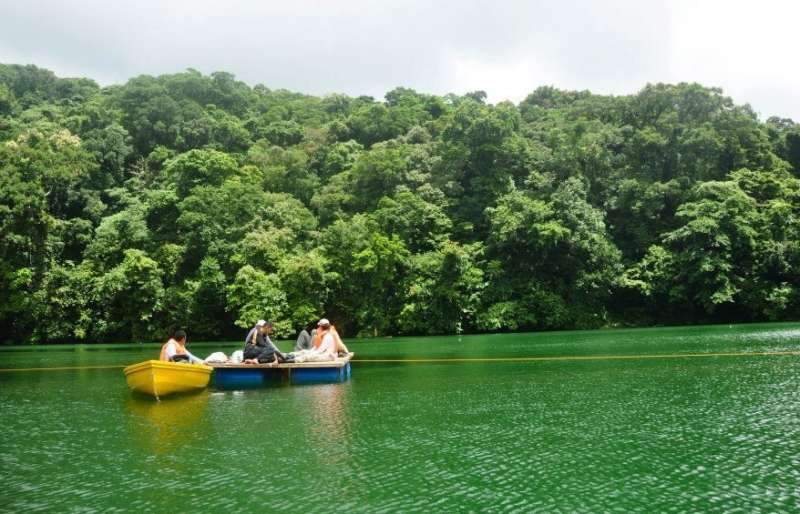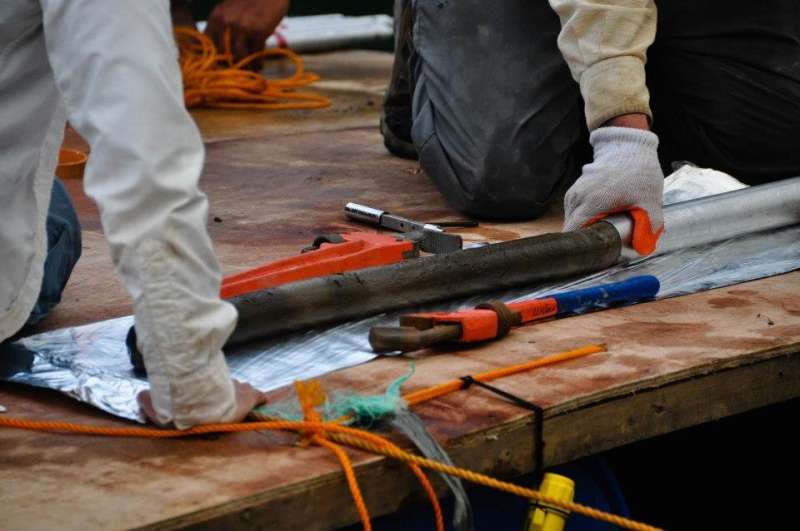This article has been reviewed according to Science X's editorial process and policies. Editors have highlighted the following attributes while ensuring the content's credibility:
fact-checked
peer-reviewed publication
trusted source
proofread
New study reveals abrupt shift in tropical Pacific climate during Little Ice Age

An El Niño event has officially begun. The climate phenomenon, which originates in the tropical Pacific and occurs in intervals of a few years, will shape weather across the planet for the next year or more and give rise to various climatic extremes. El Niño-like conditions can also occur on longer time scales of decades or centuries.
This has been shown to have occurred in the recent past by an international research team led by Ana Prohaska of the University of Copenhagen and Dirk Sachse of the German Research Centre for Geosciences (GFZ). Their analysis of biomarkers—organic molecules or molecular fossils from vascular plants—in the sediments of a lake in the Philippines indicates an unusually dry phase in the region during the Little Ice Age between 1600 and 1900 A.D.
The results have now been published in the journal Communications Earth & Environment. They show how important the understanding of past dynamics of the tropical Pacific ocean-atmosphere climate is for the improvement of climate models and the prediction of future climate changes.
The El Niño phenomenon
A striking feature of climate in the equatorial Pacific is its east-west asymmetry, with warmer surface waters in the west and colder surface waters in the east. Easterly winds drive surface water westwards, allowing equatorial upwelling to bring cooler water to the eastern side. This asymmetry breaks down in today's climate, leading to El Niño conditions that occur at irregular intervals of a few years and last for 9-12 months.
During an El Niño event, sea surface temperatures along the equator increase from the Peruvian coast to the central Pacific. The southeast trade wind weakens considerably, and light westerly winds may develop. In the western equatorial Pacific, which is otherwise characterized by abundant precipitation, an exceptional dryness takes hold, whereas the otherwise dry eastern edges of the Pacific may experience heavy rainfall.
Against the backdrop of global warming, El Niño is expected to bring record-breaking high temperatures and various extreme climate events globally such as droughts, floods and wildfires, which will significantly affect the lives and well-being of millions of people.
El Niño-like phenomena on longer time scales
While El Niño is an interannual climate phenomenon, the climate system of the tropical Pacific can also exhibit El Niño-like behavior on longer time scales of decades and centuries, which is linked to the east-west gradient of sea surface temperatures in the Pacific.
Such behavior has been shown to have transpired in the recent past by a team led by Ana Prohaska, assistant professor at the University of Copenhagen and formerly a visiting scientist at the GFZ, and Dirk Sachse, working group leader in GFZ Section 4.6 "Geomorphology" and director of Topic 5 "Landscapes of the Future" of the Helmholtz research program "Changing Earth—Sustaining our Future."
The team describes such a pronounced shift to El Niño-like conditions in the second half of the Little Ice Age, lasting from about 1630 to 1900 A.D. What is particularly remarkable is the short period of only one generation within which conditions changed for a period of more than 200 years.

Climate insights into the past through studies of sediment cores
The research team examined sediment cores collected in 2013 from Lake Bulusan in the northern Philippines. The sediment sequence provides insights into the climatic evolution of the past 1,400 years in a region that is today strongly affected by El Niño events.
In particular, the researchers analyzed the composition of stable hydrogen isotopes in leaf wax biomarkers (δDwax). These are molecular fossils that originate from the protective surface layer of leaves from vascular plants. The analysis provides insights into water supply during their lifetime.
The study shows a sudden and significant increase in δDwax values between 1600 and 1650 A.D., indicating a shift towards drier conditions in the western tropical Pacific during the second half of the Little Ice Age. The researchers attribute this change to a shift in the mean state of the tropical Pacific Ocean related to zonal gradients, i.e., east-west differences in sea surface temperature.
The significance of the current study for climate predictions
Ana Prohaska, lead author of the study, emphasizes the importance of this research: "Our study provides compelling evidence for the intricate relationship between zonal gradients in sea surface temperature and hydrological patterns in the tropical Pacific. Understanding the nature and pace of past changes in the tropical Pacific climate system is critical for predicting future climate change and its potential impact on this vulnerable region."
Dirk Sachse from the GFZ adds, "Although there is increasing evidence that sudden climatic changes have occurred in the past, current climate models cannot reproduce such abrupt shifts in the mean state in the tropical Pacific. This highlights that the understanding of the underlying mechanisms is still limited. In the context of anthropogenic climate change, a better understanding of the drivers and consequences of the complex dynamics of the mean state of the tropical Pacific is of great importance. For this, the integration of paleoclimatological data into modern climate models plays a crucial role."
More information: Ana Prohaska et al, Abrupt change in tropical Pacific climate mean state during the Little Ice Age, Communications Earth & Environment (2023). DOI: 10.1038/s43247-023-00882-7
Journal information: Communications Earth & Environment
Provided by Helmholtz Association of German Research Centres





















